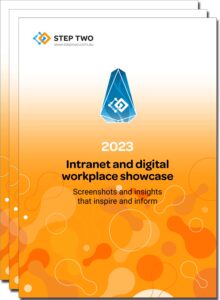
Filed under: Digital workplace, Information management
“I should be able to process 15 claims a day but the system is so slow and clunky, I get through 5 if I’m lucky.”
“The error messages just don’t make sense, we shouldn’t need a system to explain what an error means … I just want to know how to fix it.”
“I don’t know if this is what I am meant to be doing in the system but I don’t have another option.”
“I don’t understand why it looks different, it seems I come in every day and something has changed … just after I have learnt it.”
These are just a few of the user quotes we’ve heard during our recent work conducting user testing at a large organisation.
The sentiments expressed won’t be a surprise to anyone who has been involved in user experience work. Where they come from, however, may be unexpected.
For these are not comments about the organisation’s website, and nor are they about the intranet. Instead, they are about the layer that sits in between: core business systems.
What they reveal is the big missing piece of employee experience: the design of the frontline and business systems that staff use to get day-to-day work done. And there’s a lot to be fixed!
The other user experience
Every business now recognises that the design and usability of their website is paramount. Most have long since moved on to take a strategic look at their customer experience, encompassing all their customer-facing channels. Success stories from customer experience projects are now too numerous to count.
Rapidly catching up is a focus on employee experience, acknowledging that it’s impossible to deliver a great customer experience without also considering the staff environment. This has triggered many projects that look at the whole digital workplace, from the initial induction of staff, through to intranet, collaboration and HR systems.
What this misses is that customer-facing staff aren’t spending the bulk of their time using HR systems or the intranet. They’re spending almost every minute of their working day in frontline and core business systems, accessing customer details and processing transactions.
Some of these systems still date back to mainframe ‘green screen’ days, and even the more modern systems are still complex and convoluted.
What’s needed is for the scope of employee experience to encompass core business systems, not just corporate services tools.
Why CIOs should care
The most important staff in most organisations are those in customer-facing areas. They provide the fundamental services to customers, and affect much of the income and costs of the whole business.
The hard truth is that most frontline and core business systems are complex and difficult to use. They are the product of constant incremental change, punctuated by massively disruptive platform changes. There have been few opportunities to consider the design and usability of the systems.
While staff do become skilled in using these systems, it doesn’t take away the business cost of the poor employee experience.
Current challenges, however, provide future opportunities. Business benefits of improving the experience of core systems include:
- Increased staff productivity, from reducing the complexity of tasks and the time needed to complete them.
- Reduced call waiting and handling times, as a direct benefit of simpler systems.
- Reduced errors, from clarifying and simplifying the user experience of these systems.
- Reduced training time, as a byproduct of simpler and more considered designs.
- More staffing flexibility, from making it easier for staff to cross-skill on systems that have a common design.
- Better integration, particularly between systems and the knowledge bases that support them.
- Improved customer experience, from explicitly designing the employee experience to support meeting customer goals.
The good news is this: because these systems underpin frontline processes and transactions, business benefits are easy to quantify.
Many KPIs are already measured, such as call handling times, and improvements can be easily mapped back to system improvements. Measures such as customer satisfaction are also tracked, although the contribution of better employee experience may be harder to determine.
Driving customer-facing success
There’s a tremendous opportunity for CIOs to join forces with the other players in the employee experience and digital workplace spaces. With a common vision and set of goals, many practical steps can then be taken:
- Take ownership of core system design, instead of just accepting what vendors and developers choose to offer.
- Incorporate design and user testing activities into the project management methodologies for all core business systems.
- Establish design patterns and standards that will apply across all frontline business systems, to ensure consistency of experience.
- Develop an employee experience strategy that encompasses core business systems.
- Make full use of new technology options offered by vendors, particularly where they enable a more cohesive employee experience across systems.
- Consider the employee experience when choosing new solutions, evaluating vendors on their ability to offer flexibility and good design, alongside functional capabilities.
Employee experience and the wider digital workplace is now a C-Level consideration in most organisations. Now is the time to expand the scope of these discussions to encompass frontline and core business systems. With new technology options, a great employee experience for customer-facing staff will also deliver huge business benefits.
Step Two has been running several strategic projects in this space recently. Reach out to us if you’d like to hear more about what we’ve learned, and how we could help your organisation.





